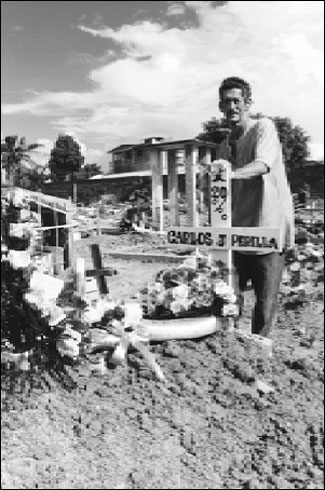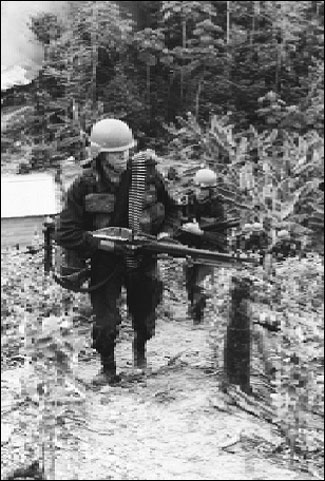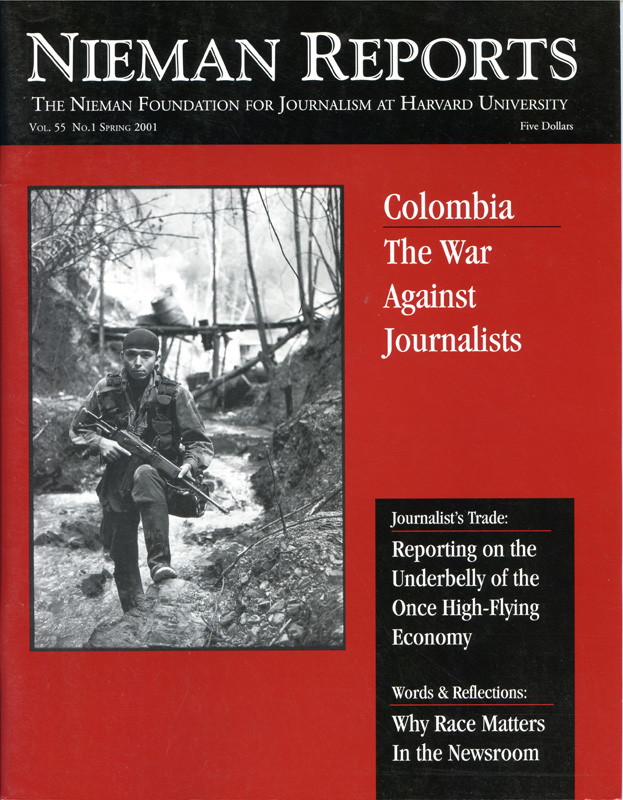
A grave digger has just buried a coca farmer, whose family members said they did not know who had killed him. One person said he was murdered by FARC guerrillas as punishment for breaking its armed blockade. Photo by Steve Salisbury.©
It was dusk on my first night with Colombia’s guerrillas. The rebel leaders stood on the dirt road, ringed by their guards, discussing what to do with me. They seemed bemused by my request to stay on to learn more. After weeks preparing to meet them, reading their voluminous communiqués and several scholarly books on the country’s 36-year-old war, I wasn’t satisfied with the afternoon’s brief interview. I had many more questions. Raul Reyes, one of the comandantes, came over. “What are we going to do with you?” he asked.
This was a rhetorical question if there ever was one. At least 20 rebels toting the latest automatic weaponry awaited his orders, so we both knew who was calling the shots. This short, bearded man in crisp fatigues, a pistol and machete on either hip, might have been testing me to see if I was serious. My hiking boots and pack suggested I’d come ready to stay. Their puzzlement was understandable since most people try to avoid becoming guests of the Revolutionary Armed Forces of Colombia (FARC).
They not only take prisoners of war but also kidnap civilians for ransom or political reasons. Americans are not exempt. Several U.S. tourists had been seized when they went bird watching in the territory of a particularly fearsome FARC comandante, and three American activists had been killed.
Accusations of spying were lodged in both cases, although Reyes told me the murders had been a mistake. It is difficult to comprehend Colombia’s climate of mayhem from the outside; hundreds of people are killed and kidnapped daily. As the last light faded behind the trees, Reyes turned to my rebel-assigned driver and said: “Take her to El Loco.”
Naturally I had second thoughts. Here I was paying some laconic mustachioed man, trusted by the FARC but unknown to me, to take me down a pitch-dark road in the middle of the jungle. I especially did not like the idea of being delivered to someone called “the crazy one.” I wondered if he was in charge of stupid, nosy journalists, but I did not want to betray my nervousness. After bouncing wildly over the ruts for another half-hour, I summoned up my most casual tone and asked, “So why is he called El Loco?” Looking right through me, the driver just laughed.
From the afternoon’s talk I could tell that the NATO bombing in Kosovo had made the rebels jumpy. Their suspicions of Americans were being fed by rumors that the United States planned to intervene in Colombia. I had done what I could to minimize their grounds for mistrust by sending word ahead through several channels about who I was, what I wanted, and when I would arrive. Nonetheless, the first person I encountered at the FARC’s liaison office, a mop-haired young man, immediately said: “You’re from the CIA, right?” We spent the rest of the afternoon playing 20 questions, while word of my arrival was radioed to the main rebel camp. The novelty of my clove cigarettes may have helped to break the ice. I was told to go out to the countryside with a driver the FARC designated. There I would meet Reyes. But I later learned that one of my intermediaries’ letters had reached Reyes that day, a lucky stroke that probably did the trick, and confirmed my belief in advance planning. The next day I was told to go out to the countryside with a driver the FARC designated.
Before I went down to FARC territory in southern Colombia, the U.S. ambassador warned me that I’d be on my own. That was hardly news to me. I had chosen to make the visit alone precisely because I couldn’t predict how the FARC would react. My editors knew my plans, although I wasn’t sure where I would stay or how long I’d be gone. On another trip I had hired a plucky British stringer, Vicky Burnett, to accompany me to a town where right-wing vigilantes were holed up after massacring a couple dozen people, but I remained reluctant to ask others to shoulder the risks of rural Colombia. The only foreign reporter I knew of who did go to the frontlines of Colombia’s war was Karl Penhaul, then of Reuters, who generously offered his advice. But as a magazine reporter looking for an exclusive story I couldn’t very well team up with a wire service colleague.
To my great relief, El Loco turned out to be a peasant known for his clownish sense of humor. He and his wife, whom he introduced as La Loca, gave me a welcome meal and the best bed in their humble home deep in the wilderness. The next day I was taken to the rebels’ camp where Reyes talked at length about their views and goals, answering dozens of questions with remarkable frankness. Some answers were chilling, such as his defense of ransom and extortion as taxation. Profiting from drugs? Everyone does it. Conscript army? The other side does it. But I came away understanding much more about the rebels, their war, and Colombia’s warped moral universe. And I got to observe how they treated each other and the civilians around them.
Since I survived these first encounters without becoming a permanent guest of the FARC, I decided to take a further risk. The FARC was in the middle of a nationwide offensive, so I made my way to one of their elite mobile units fighting some distance away. I explained to the taxi driver I hired just what I intended to do, and he accepted the job, apparently curious at my own willingness to venture out. It may also be that the rebel commander I met on the mountaintop as the government planes strafed its flanks was too surprised to see me to refuse to talk. The experience of being with rebels in combat was scary, but it could not have been more educational. I got to see for myself that this unit was as accomplished a military force as reputed, deftly capturing a town, holding it for days, and withdrawing at night without experiencing any casualties.
Why have I made it my priority for the past three years to report from the frontlines of Colombia’s war? It is a situation about which Americans are vastly ignorant and one in which the United States has become increasingly involved. That seems like a pretty good rationale to me. I can’t imagine a much worse situation than the United States wading into a place it knows virtually nothing about. I don’t minimize the dangers inherent in reporting anywhere in Colombia and certainly not in the war zone, which is coming to be most of the countryside. But the dearth of firsthand reporting from the half of the country where the government was entirely absent seemed to me like an egregious lapse posing a different sort of danger. There was no other way to learn about the FARC except to put myself in their hands. That’s just what reporting on guerrillas requires.
A question like “Why do you do it?” has many layers, including personal ones. I became a foreign correspondent because I like to get my shoes dirty and my shirt sweaty, and this story is as challenging and fascinating as it gets. In 15 years of reporting in Latin America, I’ve seen wars and anarchy, but this is an extreme case of pathological violence and social decomposition. Southern Colombia’s jungle is becoming one giant coca plantation. Going to the country is like jumping down the rabbit hole or stepping through the looking glass. But I also have the luxury of being able to leave, and this gives me a distinct advantage over reporters based inside the country, our Colombian colleagues above all, who are the most vulnerable to intimidation, threats and retaliation.
I’ve gotten out into the hinterlands, and I’ve tried to develop a comprehensive picture of the principal actors and issues—the guerrillas, the military, the paramilitaries, and the U.S. role in Colombia. Covering the first three are difficult mostly because of the very real possibility of personal danger. The fourth has been tough because the U.S. embassy has erected obstacles to reporting. Foreseeing that the media would cast the story as “another Vietnam,” the U.S. Embassy blocked access to the main topic of interest, the U.S. special forces training anti-drug battalions in the Colombian army. I did get access to the ambassador and military advisory group commander and finally to the anti-drug battalion, but the embassy warned me that if I even tried to talk to any special forces trainers I’d get no more access to any U.S. officials in Colombia.
I knew this wasn’t a bluff because the embassy had already cut off access to many reporters. Interestingly, Southern Command, the U.S. military command overseeing Latin American operations, disagreed with this approach. While it can’t override embassy press policy inside Colombia, it has offered information to explain what the United States is doing and why. Colombia’s military has allowed reporters into the field with its troops, but many believe the story is not big enough to justify the risks. Although major media have begun devoting more coverage to Colombia, frontline reporting is still limited. I’ve been warned many times not to go out with a force seen as inept and unreliable. A veteran former reporter warned me, “They’ll leave you out there and not come back.” The Colombian military has certainly suffered major debacles. Entire units have been ambushed or taken hostage en masse. And I did indeed have some unnerving experiences when I accompanied some of these forces. Soldiers slept rather than standing guard over the commander’s helicopter. And I flew into an operation with young conscripts who were so scared that they terrified me. But I’ve also been with experienced soldiers who let neophyte reporters come along for a hazardous day of dashing through guerrilla territory, blowing up cocaine labs, running through endless fields of coca. The situation was surreal. But there was nothing wrong with the way the troops or their leaders performed; they were just totally outgunned and outnumbered.
Still, for a reporter, nothing compares with being a witness to events like these. If journalists aren’t gaining this kind of firsthand information (and passing it along to readers), then decisions that involve U.S. troops and dollars will risk being made without the wisdom of understanding that Americans ought to demand. And for reporters, those who have spent even one day in a war zone know that lessons learned there are indelibly vivid, the payoff for being a foreign correspondent.

U.S. trained and equipped Colombian “Jungle Command” anti-narcotics police leave a small coca leaf processing laboratory on fire behind them. Photo by Steve Salisbury.©
Linda Robinson, a 2001 Nieman Fellow, has covered Latin America since 1989 for U.S. News & World Report.

